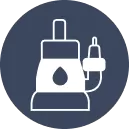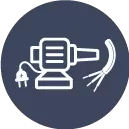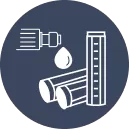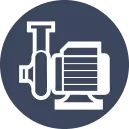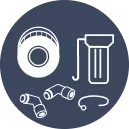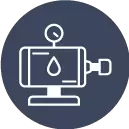The Pump & Well category encompasses all equipment used to move, store, and manage water from wells, sumps, or other sources. It consolidates pumps, tanks, pipes, electrical controls and drilling supplies. More simply, it helps keep the water flowing for homes, farms, businesses and industrial sites.
Types of Pumps and Their Uses
Below is an overview of the main pump types. Each group serves a different purpose, from pulling water out of deep wells to moving dirty water away from basements.
1. Submersible Pumps
Submersible pumps sit directly in the water they play in. This design keeps them cool and minimizes the risk of air bubbles giving them any grief. And they operate by pumping water up from deep wells or flooded areas.
They don't need priming (filling them with water) like their air-dry ones do, since they're underwater. It makes them a safe option to extract groundwater for irrigation, drinking, or draining of flooded areas.
2. Wastewater Pumps
Wastewater pumps deal with water that can contain dirt, debris and even sewage. Knowing the differences helps before picking one:
- Sump Pumps: Sump pumps are placed in a small basin (the sump pit) to eliminate water that accumulates there. They help shield basements and crawlspaces from flooding during heavy rain or rising groundwater.
- Sewage (Ejector) Pumps: Sewage pumps transport either raw sewage or greywater away from residences or small buildings into sewer lines or septic tanks. Some have grinders (macerators), which crush solids into pieces so they pass through pipes more easily.
- Effluent Pumps: After septic tanks have partially treated the wastewater, effluent pumps move this wastewater from the tanks to the drain fields. They can handle small solids but are quieter and more energy‑efficient than full sewage pumps.
- Utility Pumps: These are small, portable pumps that can deal with clean or slightly dirty water. They are great for displacing water quickly, washing down equipment and draining flooded basements.
3. Surface Pumps
Surface pumps are typically mounted above the level of the water and pull the water up from open water sources or shallow wells. They have easy access for maintenance.
- Jet Pumps: They boost water up with the help of a small nozzle and a venturi (special tube shape) from depths of up to around 25 feet. They are suitable for shallow and moderately deep wells.
- Centrifugal Pumps: These pumps utilize a rotating impeller that shoots water outwards, generating flow and pressure. They are capable of handling a broad spectrum of pressures and flow rates and are easy to maintain.
- Booster Pumps: Booster pumps raise the water pressure when used in systems with several outlets or tall buildings. They guarantee the equal flow of water to all fixtures.
4. Solar Pumps
These pumps are powered by electricity from solar panels. They are ideal for off-grid sites like remote houses, pasture watering, or garden fountains.
Because they use clean energy, they lower their power bills and minimize their carbon footprints. With fewer moving parts than conventional pumps, they often have a longer lifespan and lower maintenance needs.
Well System Components
A pump is only one part of a well system. The essential components for pressure control, well protection, and continued operation are:
1. Pressure Tanks
Pressure tanks hold water under air pressure. More water entering the tank squeezes the air sitting on top of it. This stored pressure helps maintain a consistent flow of water and prevents the pump from cycling on and off too frequently.
Minimizing on or off cycling prolongs pump life and provides a steady pressure to taps or irrigation systems. Most tanks are set to switch on the pump at approximately 30 psi and turn off at around 50 psi, but variations occur according to system requirements.
2. Pressure Switches
A pressure switch monitors the water pressure in the system. At lower pressure, below the “cut‑in” level, the switch operates the pump. When pressure hits the “cut‑off” threshold, it switches off the pump.
This automatic control ensures that there is no low pressure at the fixtures and prevents the pump from dry running. Cut-in and cut-off points should be properly adjusted to ensure smooth operation and long service life of the pump.
3. Well Caps and Seals
Well caps and seals prevent dirt, insects, and small animals from entering the well casing.
- Well Caps: These are screwed on to the outside of the casing and are designed to allow for venting while preventing contaminants from entering. Most caps feature a screened vent and gasket for a secure seal.
- Well Seals: A well seal rests within the casing. They create a water‑tight seal around the drop pipe and suspend the pump in the process. Most seals utilize rubber O‑rings for a secure fit.
Distribution Parts
When water hits the surface, it requires the proper pipes and tanks to move it to where it needs to go. The following are the major components for transporting and storing water.
Well Casing and Drop Pipe
The casing is a protective tube (often PVC or steel) that is fitted to the drilled hole. It prevents loose soil from collapsing into the well and keeps groundwater clean from surface contaminants.
Within the casing, a drop pipe (also PVC or steel) brings the water up from the pump and either to the pressure tank or to the storage tank.
Storage Tanks and Septic Tanks
Storage tanks contain fresh water for potable use, irrigation, or fire suppression. They range in size and are constructed from polyethylene, fiberglass, or steel. Above‑ground tanks are visible and easy to inspect; they take up space, while underground tanks save valuable real estate.
Septic tanks are used to store residential waste for homes not connected to a public sewer. Solids drop down, and liquids spill out into a drain field. The regular pumping keeps the whole system flowing.
Drilling Fluids and Additives
Drilling fluids (sometimes known as “mud”) cool and lubricate drill bits; transport rock cuttings out of the hole; and stabilize the walls of the borehole. Additives, including bentonite or barite (drilling “chips”), enhance the fluid’s weighting and sealing properties to minimize fluid loss to surrounding rock or soil.
Conclusion
The Pump & Well category provides a comprehensive solution for all water‑handling requirements from drinking water systems and basement sump protection to large scale irrigation and industrial dewatering. With a little knowledge of each pump type, key well components, and essential electrical and piping parts, anyone can develop a reliable and efficient water system.

